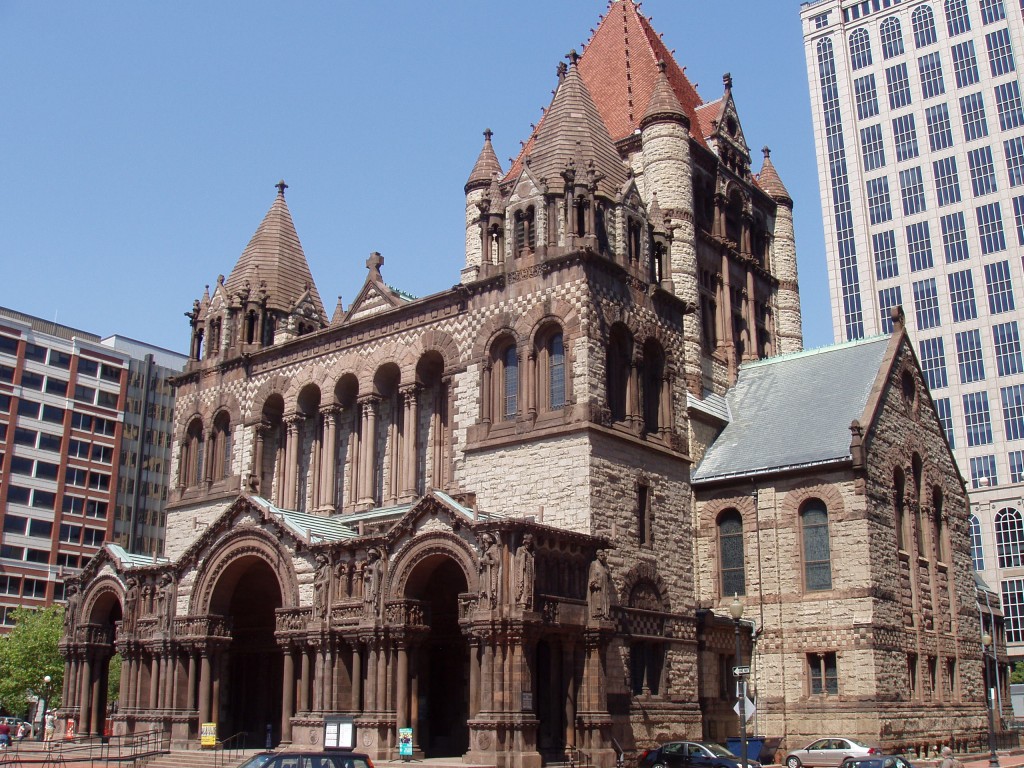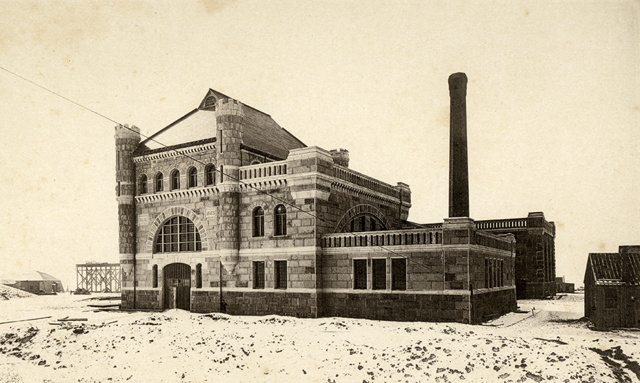
When Boston’s City Architect, George Albert Clough, set out to design the structure that would house the pumps that would power the Commission’s proposed Boston’s Main Drainage System, he choose the prominent Richardsonian Romanesque style. Named for the American architect who initiated the Romanesque revival in the United States–Henry Hobson Richardson– who designed some of Boston’s most significant structures such as Trinity Church. Regal and proud, the Romanesque style reflected the proud accomplishment of creating a brand-new modernized sewerage system. Unlike today, when municipal buildings are often created to blend in with their surroundings, the Calf Pasture Pumping Station was designed as a visual landmark, a testament to the city’s advances in technology and sanitation. Although it wasn’t accessible to everyone, it was a public building and could demonstrate that Boston’s huge sewerage treatment project had been successful.
Richardsonian Romanesque is a medieval and fortress-like design characterized by the use of rustic brick and granite in contrasting colors, heavy columns, and stone arches. Buildings designed by Richardson and in his style were constructed throughout the United States. Richardson designed Boston’s iconic Trinity Church, rebuilt in the city’s new Back Bay neighborhood in 1877 after the Great Boston Fire of 1872 destroyed its previous structure on Summer Street. Other local Richardson contributions include, what is today, the First Baptist Church (known in Boston as “Church of the Holy Bean Blowers” for the trumpeting angels on its bell tower), the Quincy Library, a suite of town buildings in the center of Easton, Massachusetts, as well as a number of train stations, commercial buildings, and private residences in Massachusetts.

Henry Hobson Richardson was born in Louisiana and raised in the South. He came to Boston in 1855 to attend Harvard University and later when on to continue his architectural studies at Tulane and the Ecole de Beaux Arts in Paris. Strongly influenced by the French Romanesque style (itself a hybrid of Gothic and Romanesque architecture), he blended that sensibility with an enthusiasm for Medieval architecture when he returned to the United States from France in 1865. The result was a unique architectural style incorporating rough-hewn granite, stone arches, the mixed use of brick and stone, and castle-like peaked roofs rising above wide columns. Richardson’s first major commission came in 1870, the Buffalo State Asylum for the Insane (today known as the Richardson Olmsted Complex) cemented him as a major American architect, and he steadily gained prominence, although it was discovered after his death that he had gravely mismanaged his finances and left his family in debt.
The elements of the Richardsonian Romanesque style are specifically incorporated and clearly noticeable in the Calf Pasture Pumping Station. Although the outside is mainly built of grey granite (the red brick window-infills are modern), there is extensive use of multicolored brick and stone to create designs and patterns inside. The squat, fortress-like structure is lined with square and arched windows and stone arches. Castle turrets adorn the corners on each level and an imposing peaked roof caps the entire structure.

Although small changes have been made to the property over the years, it retains its essential character as a Richardsonian Romanesque building. Restoring and repurposing the Calf Pasture Pumping Station would be a valuable way to preserve a piece of H.H. Richardson’s architectural legacy and New England’s history.
Sources Consulted:
- Griswold Van Rensselear, Mariana. Henry Hobson Richardson and His Works. New York: Dover Publications, 2009.
- Marwell, Stuart. Calf Pasture Pumping Station. Digital reproduction, Nabu Press, 2011.
- Phaidon, The House Book. New York: Phaidon Press, Inc., 2001.
Photo Credits:
- Louisiana Architecture Bureau: www.la-ab.com
- Dorchester Historical Society: http://www.dorchesterhistoricalsociety.org
- National Register of Historic Places: http://www.nps.gov/nr/
